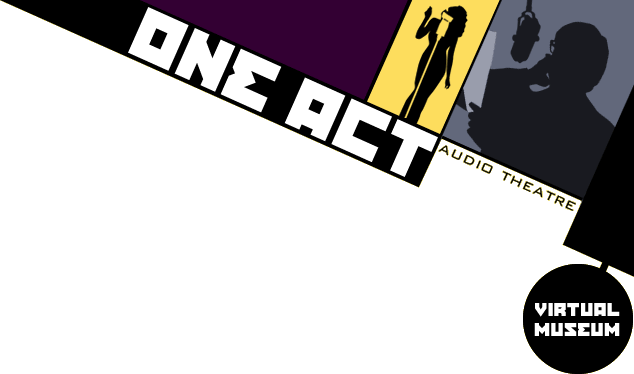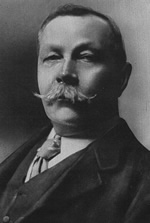Virtual Museum
The Adventures of Sherlock Holmes
A Brief History
Without question one of the most recognized and beloved characters ever created is Sir Arthur Conan Doyle's Sherlock Holmes. As Doyle scholar Vincent Starett noted, "(Holmes is) a symbol as familiar as the Tower of London, a name that has become a permanent part of the English language. A larger literature has grown around him than around any other character except Hamlet."
It is no surprise then that a fair number of people to this day believe that Holmes is not a fictional character at all, but a once living and breathing thinker of the first order, quick to assist clients ranging from a scandal-prone European aristocracy to Scotland Yard's often baffled detectives. And let us not forget the many and varied commoners from all walks of English life who found their most perplexing puzzles swiftly pieced together by Holmes, and who today give us a wonderful peek into Edwardian England.
As great as his popularity might be, and as long-lasting as his legend has proven, Holmes is a fictional construct. It is known through Doyle's own comments that Holmes is based on Dr. Joseph Bell, whose reputation at the Royal Infirmary in Edinburgh, Scotland was legendary. Dr. Bell amazed medical students, including a young Doyle in 1876, with his "miraculous" diagnostic abilities, often deducing a patient's ailment "as soon as they walked through the door, sometimes before they had opened their mouths... He would tell them their symptoms and even give them details of their past life, and very seldom was he in error." Sound like someone we know?
Sherlock Holmes in Print
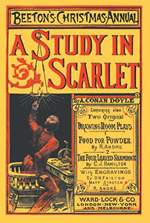 In 1887 the first Holmes story, A Study in Scarlet, appeared in a small paperback, The Beeton's Christmas Annual, for which Doyle received £25 ($60) and tepid reviews. Holmes' existence very nearly ended right there, but in February 1890 The Sign of the Four appeared as the lead story in Lippincott's Monthly Magazine and was better received. After A Scandal in Bohemia was published in the Strand Magazine in July of 1891, however, it seemed no one could get enough of The Adventures of Sherlock Holmes.
In 1887 the first Holmes story, A Study in Scarlet, appeared in a small paperback, The Beeton's Christmas Annual, for which Doyle received £25 ($60) and tepid reviews. Holmes' existence very nearly ended right there, but in February 1890 The Sign of the Four appeared as the lead story in Lippincott's Monthly Magazine and was better received. After A Scandal in Bohemia was published in the Strand Magazine in July of 1891, however, it seemed no one could get enough of The Adventures of Sherlock Holmes.
The Strand published the Holmes adventures throughout 1891, 1892 and 1893, making Doyle the most popular writer of short stories in England, but the work was all-consuming, and he soon grew tired of the character. He wanted to branch out from the detective genre to write historical novels (The White Company) and even science fiction (The Lost World), and so in the twenty-sixth Holmes story penned by Doyle, The Final Problem, the author did the unthinkable: He KILLED Sherlock Holmes.
 "That's that," Doyle remarked with finality, but the dismissal would prove more difficult than the author anticipated -- the public it seemed was not yet ready for such an end. Doyle was assailed from all sides to resurrect the great detective, especially from the Strand who saw 20,000 subscriptions cancelled, but he held out for nearly ten years. Then in 1902, the year of his knighthood, Doyle relented and The Hound of the Baskervilles was published, quickly devoured by a reading public ravenous for Holmes' brilliant deductions and Watson's faithful assistance.
"That's that," Doyle remarked with finality, but the dismissal would prove more difficult than the author anticipated -- the public it seemed was not yet ready for such an end. Doyle was assailed from all sides to resurrect the great detective, especially from the Strand who saw 20,000 subscriptions cancelled, but he held out for nearly ten years. Then in 1902, the year of his knighthood, Doyle relented and The Hound of the Baskervilles was published, quickly devoured by a reading public ravenous for Holmes' brilliant deductions and Watson's faithful assistance.
Hound was followed in 1903 by the next series of adventures, The Return of Sherlock Holmes, then came The Adventure of the Empty House, and next was His Last Bow (another vain attempt at ending his character's career). Finally in 1927, Doyle concluded the Holmes canon, forty years after he began it, with The Casebook of Sherlock Holmes.
A short three years later, Sir Arthur Conan Doyle, aged seventy one and in ill health, died... but Sherlock Holmes? Ah, how well he would live on!
Sherlock Holmes on Stage, Screen and Airwaves
Sherlock Holmes transitioned from the pages of Doyle's books to virtually every artistic genre except perhaps interpretive dance (tho I have found reference to a ballet, so perhaps this is untrue)! The first major actor to appear as Holmes was William Gillette who appeared on stage in over 1,200 performances from the turn of the 20th Century to the 1930s.
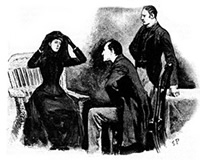 The Speckled Band, illus. Sidney Padgett
The Speckled Band, illus. Sidney PadgettHolmes' stories have been a recurring part of radio programming since 1930, with Yankees beating the BBC in tackling this decidedly British icon. Over 600 Holmes-related broadcasts have been cataloged, but no one knows the full number, especially as this partial count does not even consider foreign language productions!
 Radio and film projects went hand-in-hand for the better part of the 1930s and 1940s with actors such as William Gillette, Arthur Wontner and Basil Rathbone doing double duty as Holmes for both genres. Orson Welles' Mercury Theatre produced several radio scripts for American audiences on CBS radio in the late 30s. Another very notable radio pair is John Geilgud and Ralph Richardson who performed weekly on the radio from 1954-1955. The longest-running pair featured Norman Shelley and Carleton Hobbs from 1952-1969. The most comprehensive radio performances belong to Clive Merrison and the late Michael Williams who produced the entire canon for BBC Radio between 1988 and 1998. Merrison has gone on to produce non-canon material, now teamed with Andrew Sachs as Dr. Watson.
Radio and film projects went hand-in-hand for the better part of the 1930s and 1940s with actors such as William Gillette, Arthur Wontner and Basil Rathbone doing double duty as Holmes for both genres. Orson Welles' Mercury Theatre produced several radio scripts for American audiences on CBS radio in the late 30s. Another very notable radio pair is John Geilgud and Ralph Richardson who performed weekly on the radio from 1954-1955. The longest-running pair featured Norman Shelley and Carleton Hobbs from 1952-1969. The most comprehensive radio performances belong to Clive Merrison and the late Michael Williams who produced the entire canon for BBC Radio between 1988 and 1998. Merrison has gone on to produce non-canon material, now teamed with Andrew Sachs as Dr. Watson.
 To date there have been over 250 cinematic releases featuring Sherlock Holmes and Dr. Watson. Probably the most recognized actors in the roles are Basil Rathbone and Nigel Bruce. Nearly forgotten is Eille Norwood who portrayed Holmes in 47 half hour silent films 1921-1923. Other notable names to have donned the deerstalker cap for the big screen include the previously mentioned Arthur Wontner as well as John Barrymore. Peter Cushing starred as Holmes in the 1958 Hammer Studios version of The Hound of the Baskervilles (it was to launch a film series that never materialized). Worth mentioning is this was the first Holmes film to be shot in color. To round out the list let us mention the Christophers (Lee and Plummer). And let's not forget Nicol Williamson and Robert Duval meeting up with Alan Arkin as Sigmund Freud to wrestle with Holmes' internal foes in The Seven Percent Solution, the first Holmes film I saw on the big screen.
To date there have been over 250 cinematic releases featuring Sherlock Holmes and Dr. Watson. Probably the most recognized actors in the roles are Basil Rathbone and Nigel Bruce. Nearly forgotten is Eille Norwood who portrayed Holmes in 47 half hour silent films 1921-1923. Other notable names to have donned the deerstalker cap for the big screen include the previously mentioned Arthur Wontner as well as John Barrymore. Peter Cushing starred as Holmes in the 1958 Hammer Studios version of The Hound of the Baskervilles (it was to launch a film series that never materialized). Worth mentioning is this was the first Holmes film to be shot in color. To round out the list let us mention the Christophers (Lee and Plummer). And let's not forget Nicol Williamson and Robert Duval meeting up with Alan Arkin as Sigmund Freud to wrestle with Holmes' internal foes in The Seven Percent Solution, the first Holmes film I saw on the big screen.
Numerous Holmes spoofs exist, including films by Buster Keaton, Abbott and Costello, Gene Wilder, as well as some interesting pairings such as George C. Scott and Joanne Woodward teaming up as the crime-solving duo. Something we would love to see (or even just hear) is the 1949 NBC Texaco Star Theatre television send-up with Milton Berle, Victor Moore and a surprise appearance by Basil Rathbone himself. My personal favorite Holmes send- up is Peeper Radio Theater's 30 Second Holmes, an outrageously amusing condensing of the cases; short, indeed, yet still mostly recognizable (they don't always make the deadline however... listen for the bell).
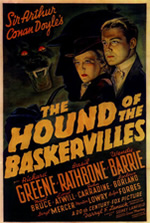 Nearly all of the motion pictures quickly made their way to television, but there has also been nearly 20 made-for-TV movies, as well as 14 separate television series over the years, again only counting English language productions. Without a doubt the most often adapted story is The Hound of the Baskervilles with separate TV films broadcast in 1968, 1972, 1982, 1983, 1985, 1996 and 2000 to name just a few of the more recent productions.
Nearly all of the motion pictures quickly made their way to television, but there has also been nearly 20 made-for-TV movies, as well as 14 separate television series over the years, again only counting English language productions. Without a doubt the most often adapted story is The Hound of the Baskervilles with separate TV films broadcast in 1968, 1972, 1982, 1983, 1985, 1996 and 2000 to name just a few of the more recent productions.
The first television series was produced by the BBC and broadcast in June of 1951; as expected, the BBC has produced the bulk of the English language films and series for television, and as noted above, admirably still produces Holmes for radio. One of the finest of the TV series starred Douglas Wilmer and Nigel Stock in 13 shows from 1964 to 1965. Peter Cushing took over for Wilmer when the series continued with 16 shows in 1968 and 1969. Next to Rathbone -- and until Jeremy Brett -- Cushing is probably the most recognized person portraying Holmes. This fact makes it very interesting to note that Cushing was less than pleased with his performance, citing the mental and physical tolls resulting from the demands of quick TV production schedules. Not so displeased that he could refuse to reprise the role for UK Channel 4 in 1984; The Masks of Death shows Cushing portraying Holmes in later life
Back in the US, Rathbone reprised his most famous role in 1953 for a live 30 minute broadcast, The Adventures of the Black Baronet. This was shown as part of the CBS television series Suspense (also a popular radio series), and intended as a pilot for a future series, but no network chose to produce further scripts. The first and only American television series, The New Adventures of Sherlock Holmes, broadcast in 1954, consisted of 39 half hour original stories produced by NBC.
 The BBC produced Murder Rooms (The Dark History of Sherlock Holmes) was shown as part of the PBS series Mystery! beginning in 2000 with four further episodes airing between 2001 and 2002. Murder Rooms is the fictional account of a young Doyle (Charles Edwards) during his years of medical training under Dr. Joseph Bell (Ian Richardson). Richardson's portrayal of a crime-solving Bell demonstrates all of the characteristics Doyle would (supposedly) later use in his Holmes writings. And while it is known that in real life Bell indeed performed forensic inquiries for the police, whether Doyle drew upon real cases, or whether Dr. Bell supplied Doyle with any material that later appeared in the adventures of Sherlock Holmes ... ahhh, that remains a mystery.
The BBC produced Murder Rooms (The Dark History of Sherlock Holmes) was shown as part of the PBS series Mystery! beginning in 2000 with four further episodes airing between 2001 and 2002. Murder Rooms is the fictional account of a young Doyle (Charles Edwards) during his years of medical training under Dr. Joseph Bell (Ian Richardson). Richardson's portrayal of a crime-solving Bell demonstrates all of the characteristics Doyle would (supposedly) later use in his Holmes writings. And while it is known that in real life Bell indeed performed forensic inquiries for the police, whether Doyle drew upon real cases, or whether Dr. Bell supplied Doyle with any material that later appeared in the adventures of Sherlock Holmes ... ahhh, that remains a mystery.
The most recent Holmes production to air on US television is the 2004 BBC produced The Case of the Silk Stocking, appearing on PBS Masterpiece Theater in 2005 and several reprises thereafter. This is a non-canon pastiche story following Holmes' pursuit of a serial killer with a foot fetish, not a typical Holmes-type plot line, but the foggy London atmospherics are captured perfectly. Performances by Rupert Everett (Holmes) and Ian Hart (Watson) are both quite enjoyable and unique, although by overtly focusing on Holmes' opiate addiction, Everett's particularly languid interpertation will undoubtedly leave some traditional Sherlockians miffed (but then, when you think about it, they are easily miffed anyway).
Holmes' stories have been adapted for children as well, including the Steven Spielberg produced "Young Sherlock Holmes", a film which examined the deductive brilliance of the detective's early years. A recent animated television series features a female Inspector Lestrade of New Scotland Yard bringing a cryogenically preserved Sherlock Holmes back to life to help solve crime in the 22nd Century assisted by a robotic Watson (perhaps Wattson?).
Without question the most famous, or at least the best regarded Holmes to appear on television was that portrayed by Jeremy Brett, who starred with David Burke (then later with Edward Hardwicke). Granada TV in Britain produced nearly the entire canon with Brett in the lead role over three installments from 1984 to 1994 before the actor's untimely death. This series was first broadcast in the US by PBS and then later rebroadcast on A&E. Not limited to television, Brett portrayed the great detective in a long stage run (1988-89) in The Secrets of Sherlock Holmes, again with Edward Hardwicke as Dr. Watson. It is very unfortunate that this play was never filmed.
read more about each actor
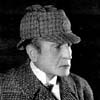 William Gillette
William Gillette Arthur Wontner
Arthur Wontner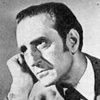 Basil Rathbone
Basil Rathbone Nigel Bruce
Nigel Bruce Clive Merrison
Clive Merrison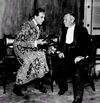 Eille Norwood with Doyle
Eille Norwood with Doyle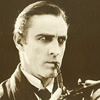 John Barrymore
John Barrymore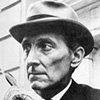 Peter Cushing
Peter Cushing Jeremy Brett
Jeremy Brett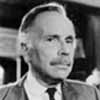 Edward Hardwicke
Edward Hardwicke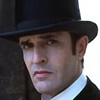 Rupert Everett
Rupert Everett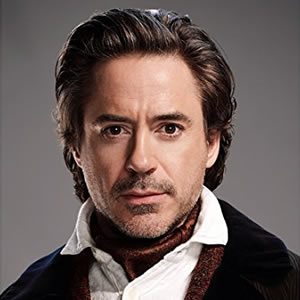 Robert
Robert
Downey, Jr.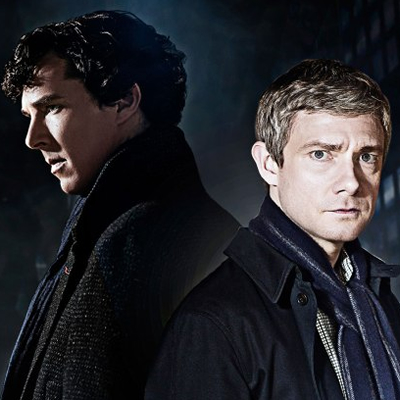 Benedict Cumberbatch
Benedict Cumberbatch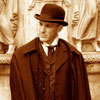 Scot Crisp
Scot Crisp
About the One Act Adaptations
The Speckled Band... A Scandal in Bohemia... and The Final Adventure... our series was selected to encompass three very distinct types of Holmes cases: A thrilling adventure... a light-hearted brain teaser with a twist... and a shocking tragedy. What more could a group of actors ask for!
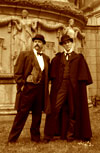 When I set to work on the scripts, it was my intention that each production run 30 minutes, half the length of the television adaptations and most recent radio plays, and the same length as the radio broadcasts from the 40s through 60s. As Doyle himself had written the stories to be read in one short sitting, my choice seemed justified. But Doyle's original stories are quite dense for a 30 minute audio production, so our plays really move in tempo, but the streamlining of story details. Scot Crisp's performance clearly pre-dates Everett's by a good two years, but there are similarities in approach to the character, and the two certainly have shared a common love-it/hate-it reaction from Holme's afficianados around the world.
When I set to work on the scripts, it was my intention that each production run 30 minutes, half the length of the television adaptations and most recent radio plays, and the same length as the radio broadcasts from the 40s through 60s. As Doyle himself had written the stories to be read in one short sitting, my choice seemed justified. But Doyle's original stories are quite dense for a 30 minute audio production, so our plays really move in tempo, but the streamlining of story details. Scot Crisp's performance clearly pre-dates Everett's by a good two years, but there are similarities in approach to the character, and the two certainly have shared a common love-it/hate-it reaction from Holme's afficianados around the world.
We hope that you enjoy our productions, and as always, The One Act Players say thanks for tuning in.
Glenn Carlson ./.
